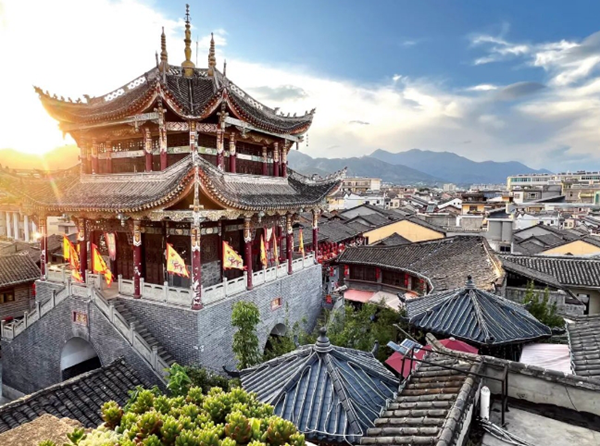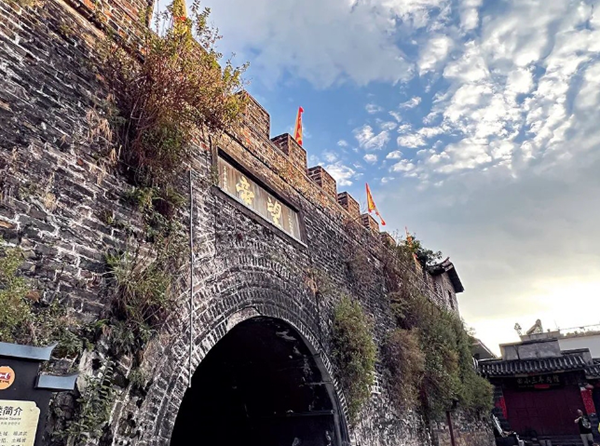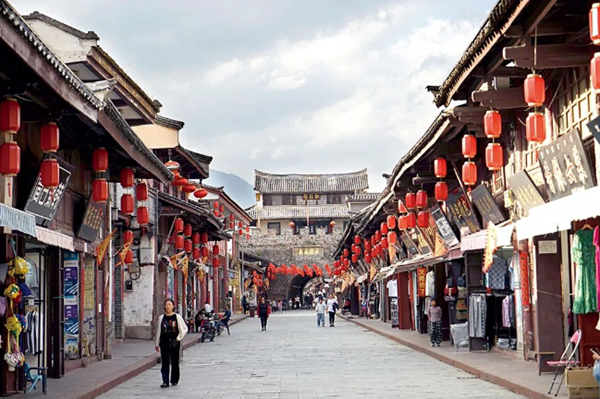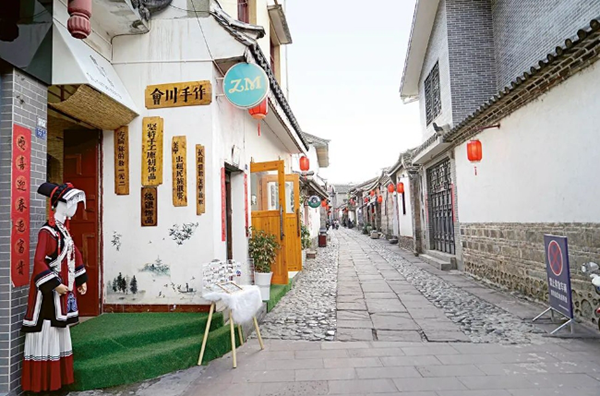Enjoying Ancient Buildings, Folk Culture in Huili

Huili Ancient Town, which has a history of more than 600 years, is situated in Huili, a city in Liangshan Yi Autonomous Prefecture, in southwest China's Sichuan Province. The ancient town has well-preserved buildings, which were built during the Ming (1368-1644) and Qing (1616-1911) dynasties. In 2011, Huili was designated a national historical and cultural city by the State Council, the central government's cabinet.
Huili is situated in the southernmost region of Sichuan Province, across the Jinsha River (the upper section of the Yangtze River) from the city of Kunming and Chuxiong Yi Autonomous Prefecture, both in southwest China's Yunnan Province.
Huili's terrain and climate are similar to those in Kunming, which is known as the "spring city" for its mild climate and year-round green environment. So, Huili is often referred to as "small spring city."
Huili was established in 111 BC, during the reign of Emperor Wudi, of the Western Han Dynasty (206 BC-25 AD). During ancient times, Huili was known as a gateway to Sichuan and Yunnan provinces. Due to its geographic position, it was an important military post, and a political, economic and cultural center in the border area of Sichuan and Yunnan provinces.

During ancient times, Huili was governed by regimes of ethnic groups (mainly the Yi and Bai ethnic groups) in Yunnan for several hundred years. Thus, the local buildings, customs and culture were greatly influenced by those ethnic groups. The pronunciation of the Huili dialect is similar to that of the Kunming dialect. The locals cook with specialty Yunnan ingredients and spices from Sichuan, blending Yunnan flavor with Sichuan cuisine.
Huili was an important courier station along the ancient southern Silk Road route, where goods were carried by horse caravans through many countries, in south and southeast Asia, for more than 2,000 years. The section of the Silk Road route through Huili was about 125 kilometers long, running from north to south.
Huili Ancient Town is the best-preserved ancient town along the route. With a long history and a rich culture, the town's traditional layout, construction style and culture have their own distinct features. The town's cultural deposits and historical remains are of great value; many of the ancient buildings, including towers, temples, courtyards and dwellings, date back to the Ming and Qing dynasties.

Lingxiao Tower, which is situated in the center of the ancient town, is one of the most distinctive landmarks. There is a bell and a drum in the tower. So, it is also called the bell and drum tower. Construction of the tower began in 1734, during the reign of Emperor Yongzheng (1678-1735), of the Qing Dynasty. It was completed during the reign of Emperor Qianlong (1711-1799), of the Qing Dynasty. The tower was destroyed around 1860. It was rebuilt during the reign of Emperor Guangxu (1871-1908), of the Qing Dynasty. In 1877, Ma Zonglong, an architect, calligrapher and painter in Huili, designed and oversaw reconstruction of the tower. Ma referred to some elements of the corner towers of the Forbidden City (in Beijing) when designing Huili's bell and drum tower. The roof of the tower is similar to that of the corner tower of the Forbidden City, which is rare in southwestern China.

Every day, at 7:30 am and again at 7:30 pm, the locals, wearing Han-style clothing, ring the bell and beat the drum. First, they walk around the tower three times. Then, they burn incense and recite the blessing before they ring the bell and then beat the drum in the morning. In the evening, they repeat the steps of walking and burning incense, but they beat the drum and then ring the bell.
"During ancient times, bells were rung in the morning, to wake people up. The ringing bells reminded them to open the gates and go out for work. Drums were beaten, in the evening, to announce the arrival of night. The roll of drums reminded people to get off work and return home," says Tu Daiyun, who participates daily in the ceremony.

Huili also has "red-tourism" attractions. In 1935, the Central Red Army crossed Jinsha River, from Jiaopingdu, a town in Yunnan Province, and the Red Army arrived in Huili. The Political Bureau of the Central Committee of the Communist Party of China (CPC) held the famous "Huili Conference" in the city. The Huili Memorial to Red Army's Long March, which displays many pictures and objects from the conference, is a national patriotic education base.

Green-glazed pottery, a specialty in Huili, dates back to the Song Dynasty (960–1279). It's called "green" pottery because it contains malachite, which turns green when burned in high temperatures. The pottery is famous in Sichuan. It was listed as an item of the province's intangible cultural heritage in 2009.
Photos by Zhang Jiamin
(Women of China English Monthly September 2023 issue)
Please understand that womenofchina.cn,a non-profit, information-communication website, cannot reach every writer before using articles and images. For copyright issues, please contact us by emailing: website@womenofchina.cn. The articles published and opinions expressed on this website represent the opinions of writers and are not necessarily shared by womenofchina.cn.








.jpg)

 WeChat
WeChat Weibo
Weibo 京公网安备 11010102004314号
京公网安备 11010102004314号